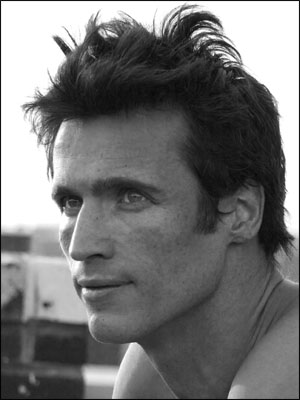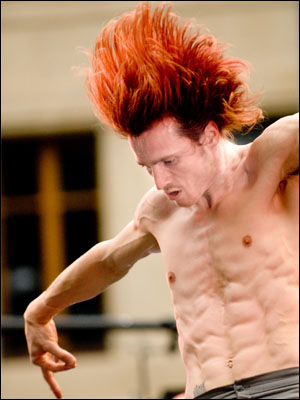Manuel Vignoulle
passionately following his dreams and instincts
for the sake of dance...

Peridance Capezio Center is pleased to be joined by Manuel Vignoulle for an intensive workshop taking place March 5th-9th, 2012!
_______________________________________________________________________
Manuel Vignoulle has a truly inspiring story.
Starting from a young age, Manuel knew he wanted to dance professionally and was eager to face any challenges or obstacles that stood in his way. As his professional dance career began to boom in France, Manuel received a call from Swan-Benoit Pouffer, Artistic Director of Cedar Lake Contemporary Ballet with an offer to join the company. In order to grow as an artist, performer, and choreographer, he accepted this rare opportunity and moved to New York City!
In an interview posted below, Manuel reveals the challenges and difficulties he faced while adapting to a different culture, an unfamiliar dance community, and above all, a new life.
Born in France, he studied at the Conservatoire National Supérieur de Danse (Paris) and went on to work with contemporary French choreographers including Claude Brumachon, Corinne Lanselle, Karine Saporta and Bernardo Montet.
Manuel worked with Redha, a modern-jazz choreographer, and has performed for television, film, fashion, opéra, and musicals. He has also been assistant choreographer in collaboration with Alvin Ailey (USA), Het Nationale Ballet (Netherlands) and State Theater Dance Company (South Africa).
In recent years, Manuel danced for Ballet du Grand Theatre de Genève (Switzerland) - which was named best European ballet company in 2006. There he worked with choreographers such as Sidi Larbi Cherkaoui, Adonis Foniadakis, Cisco Aznar, Annabelle Ochoa Lopez, Carolyn Carlson, Benjamin Millepied, John Neumeier, and Malou Airaudo, among others.
At Cedar Lake Contemporary Ballet (New York) Manuel has performed works by Ohad Naharin, Hofesh Shechter, Didy Veldman, Jo Stromgren, Alexander Eckman and Benoit- Swan Pouffer. Manuel appeared as a guest for La La La Human Steps (Canada), the Het Nationale Ballet (Netherlands), State Theatre (South Africa), and The Forsythe Company (Germany).
He is currently a freelance choreographer, performing his work in Switzerland, France, and New York.
“Dance, an art without borders, uses the human body as raw material moving through space, generates feelings that touch people's hearts, and leads them to reconnect with their own humanity.”
~Manuel Vignoulle
After 5 years in Geneva Ballet, I was a bit bored of being “just a dancer.” I was ready to focus all of my energy into my own creative work. But, in the meantime, Swan-Benoît Pouffer presented me an opportunity to join Cedar Lake Contemporary Ballet.

I always wanted to move abroad, far from Europe. I wanted to have new experiences artistically and culturally. For the first time, I had the opportunity to move to a new, great place and perform truly amazing and really interesting repertoire at the same time, which is very rare! That’s why I decided to move to New York!
2. Was moving to New York a difficult decision for you and why?
The decision wasn’t easy. Financially, I had a very good situation in Europe. After being a professional dancer for 14 years in Europe, my network was dense. I didn’t have to prove myself as much anymore.
New York presented a new and truthful challenge, and I love to be challenged. I knew I would have to prove myself again, adapt to a new way of working, a new aesthetic, a new state of mind, and a new life. Everything was unknown, but exciting!
3. When you left your family and friends in France, do you feel you grew more as an independent artist?
I left my parent’s place for dance school at age 12, so I quickly became acclimated with moving around a lot for work. I made amazing friends everywhere I went. With internet and skype now, it is so easy for me to keep touch with the people I care about despite the distance. Anyway, nothing was a big deal compared to the call from Swan to come to NY, this move was something I felt in my guts.
Yes, I do now feel more empowered and driven as an independent artist, but it is not only because of the distance but more because of the new experiences I had which I revealed in my work. It is because of these experiences that it is now clear to me: what I want to do, where I want to go, what I want to develop in my movement, what I want to share with dancers, and the message of my work.
4. What were some of the most challenging cultural differences for you to adapt to?
The amount of time you have to prove yourself is very small in American culture. You have to prove very quickly that you are good or amazing!
The way you have to sell yourself…as the best ever dancer, choreographer, artistic director, whatever… in the world! This was a real culture shock for me.
There are a lot of rules in American culture and there is a very small spectrum of what is good and what is bad, or what you should and should not do. There is no point in arguing either, it's just a big waste of time.
 |
| Manuel and Luciana Reolon In Conversation, choreographed by Manuel Vignoulle Photo by Gregory Batardon |
I would just say that in Europe, we are taught to make the movement happen or appear from the inside. You make your own story through movement and nothing is artificial or forced. As long as you act like yourself and be as simple and true as possible, people and the public will come to you, you don't have to go find them. Also, you don’t need to show off and dance as if you are saying "look at me, look at me!"
Here, dance seems to be less mental, more natural ( I love to see people dancing in the subway !) and above all more fun. Sometimes , when you take dance too seriously, you forget the pleasure and the funny side of it and loose the purpose, love and passion of dance.
6. Are you working on any new, exciting choreography projects at the moment that you would like to share with our fans?
I am now working on different projects with photographers, painters, comedians, and of course, dancers. I like to mix arts. I think it is what we can expect to see in the future, even though I do believe that the rawness of dance can stand alone by itself.
Nothing is more important to me than to create emotions in people's hearts, and allow them to reconnect with their own humanity.
Nothing is more important to me than to create emotions in people's hearts, and allow them to reconnect with their own humanity.
7. What is your choreographic process like and what are some of your sources of inspiration?
I have multiple sources of inspiration but the biggest one is life itself, then our personal experiences, situations we encounter, all what you see, smell, hear, touch and feel.
8. What can dancers expect to learn in your workshop?
The class is designed for dancers to test, challenge, and better their ability to follow the given combination with accuracy and precision, without losing their personality in the process, or the quality that makes each one of them unique. Essentially, class is the place where you experiment with new ways of using your body- new ways of thinking within your body for a better understanding of your dancing.
8. What can dancers expect to learn in your workshop?
The class is designed for dancers to test, challenge, and better their ability to follow the given combination with accuracy and precision, without losing their personality in the process, or the quality that makes each one of them unique. Essentially, class is the place where you experiment with new ways of using your body- new ways of thinking within your body for a better understanding of your dancing.
Check out our video of his Contemporary Workshop at Peridance:

No comments:
Post a Comment